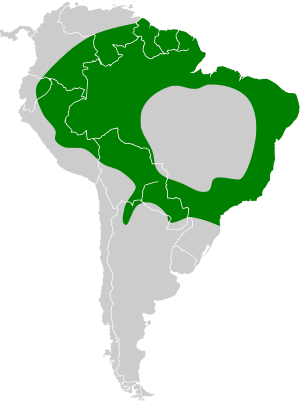Flat-faced fruit-eating bat facts for kids
Quick facts for kids Flat-faced fruit-eating bat |
|
|---|---|
 |
|
| Conservation status | |
| Scientific classification | |
| Genus: |
Artibeus
|
| Species: |
planirostris
|
 |
|
| Synonyms | |
|
Artibeus jamaicensis planirostris |
|
The flat-faced fruit-eating bat (Artibeus planirostris) is a type of bat found in South America. It belongs to the family Phyllostomidae. Sometimes, people thought it was a subspecies of the Jamaican fruit bat. However, the flat-faced fruit-eating bat is bigger. It also has faint stripes on its face and an extra tooth in its upper jaw. Scientists have also looked at their genes and found they might not be very closely related.
What They Look Like
Flat-faced fruit-eating bats are medium-sized bats. Adult bats are about 8 to 11 centimeters (3 to 4 inches) long. They weigh between 40 and 69 grams (1.4 to 2.4 ounces). Their fur is brownish-grey on most of their body. It becomes grey underneath. They have faint whitish stripes on their face.
As their name suggests, these bats have a wide head and a short nose. Their ears are shaped like triangles with round tips. They are shorter than the ears of many other bats. They also have a small piece of cartilage in their ear called a tragus. Their snout has a clear, triangular nose-leaf. This is a special skin flap that helps them with echolocation. Their wings are dark brown or black. The tips of their wings are white. They have a well-developed membrane between their legs called a uropatagium, but they do not have a visible tail.
Where They Live
Flat-faced fruit-eating bats live in many parts of northern and central South America. You can find them east of the Andes mountains. They live in different kinds of forests. These include mountain forests, forests that are changing, and lowland tropical forests. They also live in open cerrado areas. They can be found from sea level up to 2,000 meters (about 6,500 feet) high.
There are three main types, or subspecies, of this bat:
- Artibeus planirostris planirostris - found in eastern Brazil and Paraguay.
- Artibeus planirostris fallax - found in southern Venezuela and Colombia, the Guyanas, and through central and western Brazil to eastern Bolivia and northern Argentina.
- Artibeus planirostris hercules - found in eastern Peru and eastern Ecuador.
How They Live
Flat-faced fruit-eating bats are nocturnal. This means they are active at night. They are also herbivorous, which means they mostly eat plants. They eat almost only fruit. Sometimes, they might eat small amounts of insects and mites. They are busy throughout the night. During the day, they rest in trees.
They especially like fruits from Vismia trees, figs, and Amazon grape. These bats seem to be able to have babies all year long. However, in some places, more babies are born during the wet season. A mother bat is pregnant for at least three and a half months. She usually gives birth to one baby bat.
See also
 In Spanish: Artibeus planirostris para niños
In Spanish: Artibeus planirostris para niños


